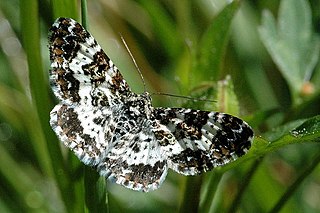
Moths are a group of insects that includes all members of the order Lepidoptera that are not butterflies. They were previously classified as suborder Heterocera, but the group is paraphyletic with respect to butterflies and neither subordinate taxa are used in modern classifications. Moths make up the vast majority of the order. There are thought to be approximately 160,000 species of moth, many of which have yet to be described. Most species of moth are nocturnal, although there are also crepuscular and diurnal species.

The luna moth, also called the American moon moth, is a Nearctic moth in the family Saturniidae, subfamily Saturniinae, a group commonly named the giant silk moths.

The cinnabar moth is a brightly coloured arctiid moth found as a native species in Europe and western and central Asia then east across the Palearctic to Siberia to China. It has been introduced into New Zealand, Australia and North America to control ragwort, on which its larvae feed. The moth is named after the red mineral cinnabar because of the red patches on its predominantly black wings. The species was first described by Carl Linnaeus in his 1758 10th edition of Systema Naturae. Cinnabar moths are about 20 mm (0.79 in) long and have a wingspan of 32–42 mm (1.3–1.7 in).

The common carpet or white-banded toothed carpet is a moth of the family Geometridae. The species was first described by Otto Friedrich Müller in 1764. It is found throughout the Palearctic and the Near East. In North America it ranges across the northern tier of the United States plus every province and territory of Canada.

The Sciaridae are a family of flies, commonly known as dark-winged fungus gnats. Commonly found in moist environments, they are known to be a pest of mushroom farms and are commonly found in household plant pots. This is one of the least studied of the large Diptera families, probably due to the small size of these insects and the similarity among species.

Polish cochineal, also known as Polish carmine scales, is a scale insect formerly used to produce a crimson dye of the same name, colloquially known as "Saint John's blood". The larvae of P. polonica are sessile parasites living on the roots of various herbs – especially those of the perennial knawel – growing on the sandy soils of Central Europe and other parts of Eurasia. Before the development of aniline, alizarin, and other synthetic dyes, the insect was of great economic importance, although its use was in decline after the introduction of Mexican cochineal to Europe in the 16th century. Historically earlier was used Armenian cochineal scale insect, Porphyrophora hamelii, which is in a same taxonomic family Porphyrophora of the Polish cochineal and in different taxonomic family from cochineal found in the Americas.

Galium boreale or northern bedstraw is a perennial plant species of the Rubiaceae family. It is widespread over the temperate and subarctic regions of Europe, Asia and North America including most of Canada and the northern United States.

Epirrhoe tristata, the small argent and sable, is a moth of the genus Epirrhoe in the family Geometridae. The species was first described by Carl Linnaeus in his 1758 10th edition of Systema Naturae.

A wasp is any insect of the narrow-waisted suborder Apocrita of the order Hymenoptera which is neither a bee nor an ant; this excludes the broad-waisted sawflies (Symphyta), which look somewhat like wasps, but are in a separate suborder. The wasps do not constitute a clade, a complete natural group with a single ancestor, as bees and ants are deeply nested within the wasps, having evolved from wasp ancestors. Wasps that are members of the clade Aculeata can sting their prey.

Epirrhoe is a genus of moths in the family Geometridae erected by Jacob Hübner in 1825.

Gypsonoma minutana, the poplar tortricid, is a moth of the family Tortricidae. It is found in Europe and North Africa, Turkey, Transcaucasia, Ural, Kazakhstan, from central Asia to Siberia and eastern Russia, Asia Minor, Iran, Afghanistan, Mongolia, China and Japan.

Manulea pygmaeola, the pigmy footman, is a moth of the family Erebidae. It is found in the western half of the Palearctic realm, east to Altai.

Epirrhoe galiata, the galium carpet, is a moth of the family Geometridae.

Epirrhoe hastulata is a moth of the family Geometridae.

Scopula virgulata, the streaked wave, is a moth of the family Geometridae. The species was first described by Denis & Ignaz Schiffermüller in 1775. It is found from most of Europe to central Asia and northern Mongolia.

Epirrhoe tartuensis is a moth of the family Geometridae. It is known from Finland, the Baltic States and adjacent Russia.

Phoebis agarithe, the large orange sulphur, is a butterfly in the family Pieridae. It is found from Peru north to southern Texas and peninsular Florida. Rare strays can be found up to Colorado, South Dakota, Wisconsin, and New Jersey. The species has also been introduced in Hawaii. The habitat consists of open, tropical lowlands including gardens, pastures, road edges, trails and parks.

Epirrhoe molluginata is a moth of the family Geometridae. It is found from the southern part of central Europe to the Caucasus.
Tybalmia pupillata is a species of beetle in the family Cerambycidae. It was described by Francis Polkinghorne Pascoe in 1859. It is known from Brazil, Colombia, Ecuador, Guyana, French Guiana, Peru and Suriname.


















